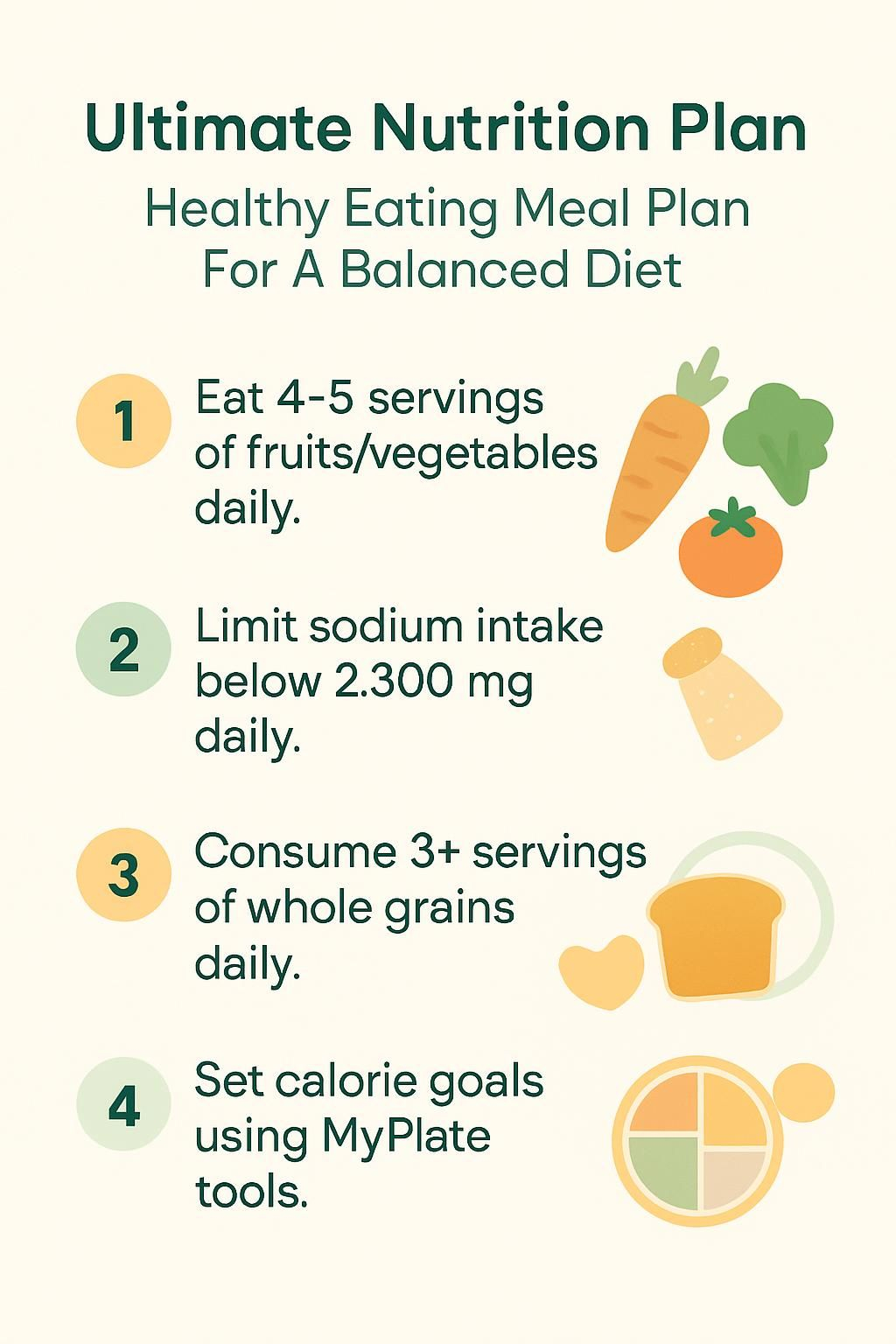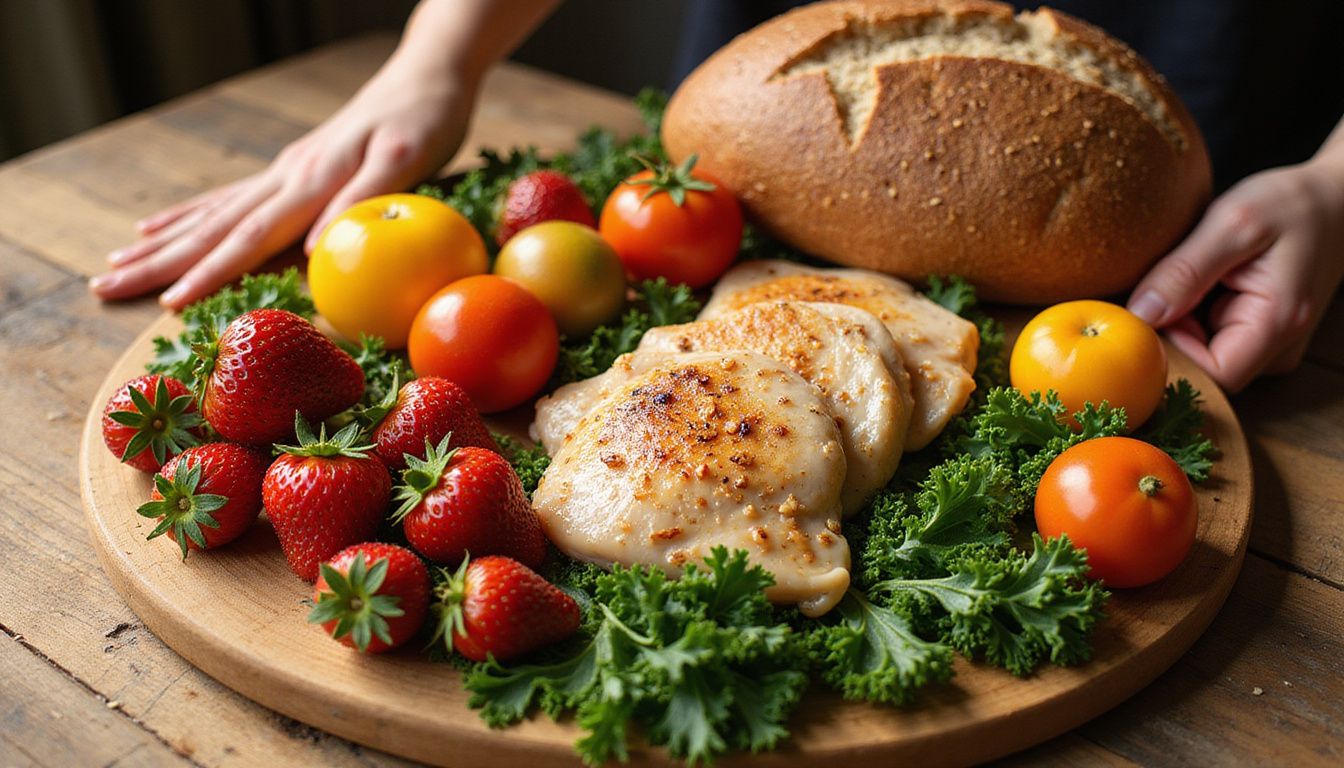Ultimate Nutrition Plan: Healthy Eating Meal Plan For A Balanced Diet
Our Nutrition Assistant AI Suite will transform your body. You will lose fat, get toned, and build muscle. Gain confidence and optimal health.
You might feel unsure about how to build a healthy eating meal plan that keeps you energized and supports a healthy weight. Research shows that a simple, structured approach like MyPlate can lower your risk of heart disease and other health problems. This guide explains what a balanced diet is, how to plan meals, and how tools like the MyPlate Plan calculator can help you manage portions and calories with less stress.
Start with one small change today and build from there.
Key Takeaways
- Following MyPlate and DASH guidelines, such as eating 4 to 5 servings of fruits and vegetables per day, supports heart health, a healthy weight, and better blood pressure.
- Swap saturated fat for healthy fats from nuts, seeds, or olive oil. Keep sodium under 2,300 mg daily, a lower target like 1,500 mg may help if you manage high blood pressure.
- Use tools like the MyPlate Plan calculator and the Shop Simple with MyPlate app to set calorie goals based on age, activity level, sex, height, and weight.
- Balanced diets that include whole grains, lean proteins, low-fat dairy, and colorful produce improve energy and help manage cravings.
- Plan meals in advance and use USDA serving sizes for portion control. Meal prep saves time and helps you stay consistent during busy weeks.

What Is a Balanced Diet and Why Is It Important?

A balanced diet gives your body the right mix of nutrients and energy each day. Getting this balance supports healthy meals, helps manage body weight, and lowers the risk of cardiovascular disease.
What Does a Balanced Diet Mean?
Eating a healthy diet means choosing vegetables, fruits, whole grains like brown rice or oats, and fat-free or low-fat dairy products such as milk or yogurt. Include lean protein sources too. Good picks are skinless poultry, fish rich in omega-3 fats, beans, eggs, and unsalted nuts.
Limit foods high in saturated fat, trans fat, sodium, and added sugar. The Food Pyramid and MyPlate show how each food group should fit into daily meals so you get many nutrients without too many calories.
Portions matter. Your needs depend on age and activity level. A simple swap like choosing whole wheat bread instead of white bread at lunch can keep you full longer. Replacing sugary drinks with water reduces calories and may improve your body mass index over time.
A balanced meal fills half your plate with vegetables and fruits. Right-sized portions help keep your energy steady all day.
Why Is a Balanced Diet Vital for Your Health?
Meeting your daily calorie needs with a balanced meal plan helps you maintain a healthy body weight. It also lowers the risk of high blood pressure, heart disease, and some cancers.
Trusted groups like the American Diabetes Association and the U.S. Department of Agriculture encourage eating plenty of vegetables, whole grains like quinoa or barley, lean meats or plant proteins, dairy or fortified alternatives, nuts, seeds, and heart-friendly vegetable oils. Plans like DASH focus on low sodium and more produce to support heart health.
Variety brings fiber for digestion, vitamins for energy, and minerals that help your body work well. Choosing nutrient-dense foods instead of sugary drinks or fatty red meats can improve cholesterol levels and lower the chance of a heart attack.
Key Components of a Healthy Eating Meal Plan
A healthy eating meal plan helps you pick foods that work together for steady energy and good blood sugar control. Think of each plate as a quick checklist of food groups.
Why Are Vegetables and Fruits Essential?
Vegetables and fruits deliver vitamins, minerals, and fiber. On a 2,000 calorie plan, the DASH diet suggests 4 to 5 servings of each per day. This pattern supports heart health, better blood pressure, and weight control.
Choose foods like broccoli, spinach, oranges, bananas, apples, sweet potatoes, and berries. These provide potassium, magnesium, calcium, and antioxidants. MyPlate recommends filling half of every meal with produce. Fresh produce usually brings more nutrition per calorie than heavily processed snacks.
Filling half your plate with fruits and veggies is a simple step that pays off for life.
What Are Whole Grains and Their Benefits?
Whole grains include all parts of the grain seed. That makes them richer in fiber, vitamins, and minerals than refined grains. Oatmeal, brown rice, whole wheat bread, popcorn, and quinoa are strong choices.
On a 2,000 calorie plan, DASH suggests 6 to 8 servings of grains with a strong focus on whole grains. People who eat three or more servings of whole grains daily often have better blood sugar control and feel full longer.
Whole grains also provide antioxidants and slow-digesting carbs that help steady energy. Try swapping white bread or pasta for whole grain versions during your next grocery trip.
How Do Lean Proteins Support Your Body?
Lean proteins like chicken breast, fish, eggs, beans, and unsalted nuts help build and repair muscle. They give key nutrients with less saturated fat and fewer calories.
Protein is one of the core MyPlate groups. On a 2,000 calorie DASH plan, aim for 6 or fewer servings of lean meats, poultry, and fish. Oily fish offers healthy fats that support brain and heart health.
Trade high fat red meats for turkey, fish, or plant proteins to meet calorie goals while protecting your heart. This approach supports weight management and strength at any age.
What Are Healthy Fats and Why Include Them?
Healthy fats come from sources like nuts, seeds, olive oil, and fish. These fats help your body absorb vitamins and support heart health.
Include small amounts, about 2 to 3 servings per day on a 2,000 calorie plan. Limit full-fat dairy and fatty meats, since they may raise blood pressure and heart disease risk. A spoonful of olive oil for cooking or a few walnuts on oatmeal is an easy way to add healthy fat.
What Are Good Dairy or Dairy Alternatives?
Choose fat-free or low-fat milk, yogurt, and cheese to get calcium, protein, and vitamin D without much saturated fat. On a 2,000 calorie plan, MyPlate and DASH suggest 2 to 3 servings per day.
If you prefer plant-based options or have lactose intolerance, try fortified soy milk or soy yogurt. These usually match dairy protein. Other plant drinks like almond or oat milk may have less protein unless fortified, so check labels.
Simple swaps help. For example, use plain nonfat yogurt instead of sour cream in recipes to trim calories while keeping taste.
How Can You Understand Portion and Serving Sizes?
Portions shape calorie intake and help you manage weight. Learning standard serving sizes makes meal planning faster and more accurate.
What Are Serving Sizes and How to Recognize Them?
Serving sizes reflect the amount most people need at one time. Using them can make your eating plan more balanced.
- One serving of cooked rice, pasta, or cereal is about one half cup. Measure it a few times to learn the look.
- For fruit, one small piece, like a four-inch apple, counts as one serving.
- One cup of raw leafy vegetables is a serving. For cooked vegetables, a half cup is a serving.
- Lean proteins such as chicken or fish should be about 3 ounces per serving, close to the size of your palm.
- For dairy, one cup of milk or yogurt usually equals one serving for adults on a DASH style plan.
- For oils and healthy fats, one tablespoon is a typical serving. Use a real spoon to avoid going over.
- Keep sweets to about five small servings per week on a 2,000 calorie plan to support heart health.
- Use visual cues. A deck of cards equals a lean meat portion; a tennis ball is similar to a fruit serving.
These cues keep calories in check while helping you hit your targets across food groups.
What Are Effective Tips for Portion Control?
Portion control is a powerful way to guide calories without strict rules. These steps help you enjoy more foods while staying balanced.
- Use smaller plates and bowls. Meals look bigger, which can help you feel satisfied with less.
- Fill half your plate with produce. Vegetables and fruits add volume with fewer calories.
- Measure foods that are high in fat or calories, like cheese or nuts, until you learn your usual amounts.
- Serve snacks on a dish instead of eating from the package.
- Read labels to understand serving sizes, especially for items with multiple servings per container.
- Stop eating when you feel satisfied, not stuffed.
- Limit seconds unless the extra is mostly vegetables.
- Track intake with an app or notebook to spot patterns.
- Choose lean cuts of meat and aim for 3 to 4 ounces per serving.
- Drink water before meals. It may help curb hunger at mealtimes.
How to Create Your Ultimate Nutrition Plan
You can build a daily plan that fits your goals, activity, and calorie needs. Keep it simple at first, then add more changes as habits grow.
How Do You Set Realistic Nutrition Goals?
Start with small, clear goals you can measure. For example, use the Start Simple with MyPlate app to track meals or add one serving of vegetables to dinner each day.
Base targets on credible guidance like MyPlate. Swap sugary drinks for water a few times per week or add a lean protein at lunch. Use tech tools for reminders and budget tips, such as the Shop Simple tool in MyPlate. Build strong habits before you take on bigger shifts.
How to Calculate Your Daily Calorie Needs?
Knowing your calorie needs helps you plan meals that fuel your day without overshooting. Follow these steps to estimate a starting target.
- Use the MyPlate Plan calculator. Enter age, sex, height, weight, and activity level.
- For ages 9 to 18, the tool uses Estimated Energy Requirement equations that adjust for growth and BMI percentiles.
- Adults 19 and older receive targets based on updated equations for BMI and activity level.
- Pregnant or breastfeeding individuals get tailored calculations that reflect body changes.
- Pick the correct activity level. More movement usually means more calories.
- Compare suggested calories to your actual intake using a food journal.
- Count all calories, including snacks, drinks, and sauces.
- If you have special health needs, ask a dietitian or healthcare provider for personalized guidance.
How to Use the MyPlate Plan Calculator Effectively?
Enter your age, sex, height, weight, and daily activity into the MyPlate Plan calculator. The tool uses Dietary Reference Intakes for children and adults to guide targets for fruits, vegetables, grains, protein foods, and dairy or alternatives.
Use the recipes and cookbooks inside MyPlate to find meals that match your plan. Track your progress in the dashboard and adjust weekly. If your household has different needs, this tool can simplify choices using trusted USDA nutrition data.
Next, see how a sample three-day meal plan might look in practice.
What Does a Sample 3-Day Healthy Eating Meal Plan Look Like?
A sample plan gives structure and makes healthy eating easier. Treat it as a template you can customize with the foods you enjoy.
What to Eat on Day 1: Breakfast, Lunch, Dinner, and Snacks?
Day 1 focuses on fiber, protein, and color. Keep portions balanced and sip water throughout the day.
- Breakfast: Mix berries with chia seeds and unsweetened almond milk. Add a splash of vanilla and a small drizzle of maple syrup if you like.
- Lunch: Build a large salad with grilled chicken for lean protein. Add strawberries, cherry tomatoes, a bit of feta, and a light honey Dijon vinaigrette.
- Dinner: Bake salmon with onions, zucchini, basil, and lemon. Serve with brown rice or quinoa for whole grain benefits.
- Snacks: Choose plain yogurt with fruit or raw vegetables with hummus for steady energy.
- Hydration: Aim for at least eight 8-ounce cups of water across the day.
- Limit added sugars by choosing fruit or a small handful of nuts instead of processed sweets.
- Track servings in the MyPlate app to stay balanced across food groups.
Starting with berries and chia can keep you satisfied until lunch. Many readers report fewer morning cravings with this simple breakfast.
What to Eat on Day 2: Breakfast, Lunch, Dinner, and Snacks?
Day 2 keeps the pattern going with whole grains, lean proteins, and fresh vegetables.
- Breakfast: Toast whole grain bread. Top with scrambled eggs, chopped cilantro, a pinch of red pepper flakes, and a squeeze of lime.
- Mid-Morning Snack: Have a cup of plain yogurt with fresh strawberries or blueberries.
- Lunch: Grill chicken breast and serve it over greens with pine nuts and sliced sun-dried tomatoes.
- Afternoon Snack: Dip sliced carrots or cucumber in hummus for fiber and plant protein.
- Dinner: Bake chicken with mixed vegetables like bell peppers and broccoli. Use a light honey soy sauce and a bit of toasted sesame oil.
- Evening Snack: Enjoy one small apple or pear with about a dozen almonds.
- Hydration: Choose water instead of sweetened beverages. A general goal is eight cups per day.
Meal prepping these items on Sunday can make weekday lunches quick to assemble and easier to enjoy.
What to Eat on Day 3: Breakfast, Lunch, Dinner, and Snacks?
Day 3 centers on nutrient-dense meals that keep energy steady from morning to night.
- Breakfast: Scramble egg whites with spinach, mushrooms, peppers, and broccoli. Add a light sprinkle of cheese for calcium.
- Lunch: Build a grain bowl with chicken or tofu seasoned with chili powder. Top with salsa for extra flavor and antioxidants.
- Dinner: Cook leafy greens like kale or similar greens with diced tomatoes and curry powder. This dish brings vitamins A and K plus warm spices.
- Snacks: Choose plain yogurt or a dairy-free alternative with sliced fruit such as strawberries or blueberries.
- More snacks: Crunch on raw carrots or bell pepper strips to boost daily vegetable servings.
- Hydration: Set phone reminders so water breaks do not get skipped.
- Prep tip: Wash and chop produce in advance to speed up weekday meals.
Most ingredients are pantry staples, which helps you stick to your plan without extra trips to the store.
Popular Dietary Approaches for Balanced Eating
Several eating patterns can support a balanced diet. Pick the approach that fits your routine and culture, then make it your own.
DASH Diet for Heart Health
DASH, or Dietary Approaches to Stop Hypertension, is designed to lower blood pressure. It emphasizes vegetables, fruits, whole grains, fat-free or low-fat dairy, fish, poultry, beans, nuts, seeds, and vegetable oils.
Limit fatty meats, full-fat dairy, sugary drinks, and sweets. Keep sodium under 2,300 mg per day, and consider 1,500 mg for more benefit if you have high blood pressure. Foods rich in potassium, calcium, and magnesium, like leafy greens and bananas, support blood pressure control. Government research shows the DASH pattern can reduce blood pressure and LDL cholesterol within weeks [1].
Choosing water instead of sweet drinks can also make mornings feel lighter yet still satisfying.
Mediterranean Diet for Longevity
The Mediterranean pattern highlights vegetables, fruits, legumes, whole grains, and nuts. Extra-virgin olive oil and fish like salmon or sardines provide healthy fats.
Studies link this eating style with longer life and a lower risk of heart disease and diabetes. Focus on lean proteins such as chicken, beans, or fish instead of red meat most days. Add herbs and spices for flavor rather than salt. Simple swaps like using olive oil for salads or snacking on fresh fruit can make meals tastier and healthier.
Plant-Based Eating for Sustainability
Plant-based eating supports good health and the environment. Researchers report that plant-forward diets use fewer resources like land and water compared to diets high in animal products. The Food and Agriculture Organization estimates that livestock farming produces a large share of global greenhouse gas emissions.
Adding more whole grains, beans, lentils, nuts, fruits, and vegetables can cut saturated fat and boost fiber. Swapping beef for black beans or tofu reduces your carbon footprint and supports heart health. Many people feel lighter and more energetic after adding plant-forward meals during the week.
How to Plan and Prepare Meals Efficiently
Meal planning reduces stress and saves time. A little structure goes a long way during busy weeks.
What Are Smart Grocery Shopping Strategies?
Shopping with a plan helps you stick to your budget and your goals. Use tools and habits that remove guesswork.
- Create a detailed list and stick to it.
- Plan weekly meals around your nutrition and calorie needs.
- Use Shop Simple with MyPlate to find budget friendly options and prep tips.
- Check store flyers or apps for deals on produce, lean proteins, and whole grains.
- Buy in-season produce. Frozen fruits and vegetables are smart, lower cost backups.
- Compare unit prices to find the best value.
- Choose store brands to save without giving up quality.
- Shop the store perimeter first for fresh items and whole foods.
- Avoid shopping hungry to reduce impulse buys.
- Bring reusable bags to stay organized.
Arriving with a clear list can help keep less healthy snacks out of your cart.
How to Prepare Meals in Advance?
Meal prep turns good intentions into daily wins. A short prep session sets you up for the week ahead.
- Pick recipes that match your balanced diet, including produce, whole grains, lean proteins, and healthy fats.
- Plan quick options for busy days, like overnight oats or grain bowls.
- Batch cook staples, such as brown rice, grilled chicken, roasted vegetables, or beans.
- Use clear containers to portion single servings for grab-and-go meals.
- Cook proteins ahead for easy salads, bowls, and wraps.
- Wash and cut fruits and vegetables right after shopping so they are ready to use.
- Store prepared foods in sealed containers in the fridge for 3 to 4 days at 40°F or below.
- Pick a weekly prep time, such as Sunday afternoon, to build a routine.
- Mix and match ingredients across meals to keep things interesting.
Many students and busy parents find that prepping lunches keeps them on track during packed weeks.
How to Incorporate Variety in Your Meals?
Variety keeps healthy eating interesting and reduces nutrient gaps. Rotate foods and flavors to cover your bases.
- Choose different colored fruits and vegetables at each meal for a wider range of vitamins and antioxidants.
- Rotate proteins. Try chicken, turkey, beans, tofu, fish like salmon or tuna, eggs, and lean beef during the week.
- Test one new recipe each week, such as a quinoa bowl or roasted Brussels sprouts.
- Use whole grains like brown rice, barley, wild rice, or whole wheat pasta for added fiber.
- Add nuts and seeds, such as almonds or chia, to salads or snacks for healthy fats.
- Include low-fat dairy or fortified soy milk for calcium and vitamin D.
- Season with herbs like basil or cilantro instead of extra salt to limit sodium.
Many readers who added more plant variety noticed higher energy within two weeks and more joy in home cooking.
What Are the Benefits of a Balanced Nutrition Plan?
A balanced plan boosts daily wellness and supports long-term health. Small choices add up to a powerful routine.
How Can It Improve Your Energy Levels?
Whole grains, lean proteins, fruits, and vegetables can stabilize blood sugar. That leads to steady energy throughout the day.
Foods with lots of added sugars or saturated fat can cause energy spikes and crashes. Choosing nutrient-dense meals supports better focus and less afternoon sluggishness. A bowl of oatmeal with berries in the morning or a piece of fruit in the afternoon are easy wins.
Summary: Eating balanced meals helps you feel alert and active during school, work, or sports.
How Does It Reduce Chronic Disease Risks?
Balanced eating patterns reduce the risk of heart disease and high blood pressure. Diets rich in vegetables, fruits, whole grains, and lean proteins are linked to lower rates of cardiovascular illness.
For example, CDC data reported in 2023 shows that people who follow balanced patterns have up to a 30 percent lower risk of heart disease. Healthy fats like olive oil support flexible blood vessels, and less saturated fat can lower LDL cholesterol. Fiber from whole grains can also help control blood sugar and reduce diabetes risk.
Consistent choices support weight control, which matters because excess weight raises risk for many chronic conditions.
How Does It Help with Weight Management?
A balanced plan helps manage weight by guiding calorie intake while supplying needed nutrients. To lose 1 to 2 pounds per week, many experts suggest cutting daily calories by 500 to 750.
Tracking food choices can prevent overeating and sharpen your sense of portion sizes. Whole grains and lean proteins increase fullness, which makes it easier to skip snacking you do not need.
How Can It Enhance Mental Clarity?
Your brain needs steady fuel. Whole grains, leafy greens, nuts, and fish help provide it. Omega-3 fats in fish can support memory, and B vitamins in greens may aid focus.
Replacing sugary snacks with fruit or protein-focused snacks can improve concentration. Regular meals prevent blood sugar dips that cause fatigue and fuzzy thinking.
What Are Common Challenges and How Can You Overcome Them?
Life gets busy, and cravings happen. A few smart tactics can keep you moving toward your goals.
How to Manage Time and Busy Schedules?
Time pressure can derail healthy eating. Structure and tools keep your plan on track.
- Use the free Start Simple with MyPlate app for daily goals and habit tracking.
- Prep meals on weekends or evenings to save time later.
- Pack portable snacks, like sliced fruit, nuts, or yogurt, for school or work.
- Write a grocery list and stick to it to save time and money.
- Set reminders for meals so you do not skip them.
- Choose recipes that share ingredients across multiple meals.
- Invite family to help prep, which speeds up the process and teaches good habits.
- Carry a reusable water bottle to support steady energy.
- Limit screens during meals to practice mindful eating.
How to Stay Consistent with Dietary Goals?
Consistency turns goals into results. Clear steps and tracking help you stick with your plan.
- Write specific daily targets, like five servings of fruits and vegetables.
- Use meal planning apps or MyPlate on Alexa for reminders.
- Track what you eat, when you eat, and how you feel.
- Prep meals during the weekend for busy weekdays.
- Keep cut fruit or nuts ready for fast snacks.
- Celebrate milestones with non-food rewards, such as a movie night.
- Share recipes with friends or family to build support.
- Adjust goals monthly based on your progress.
- Use trusted sources like USDA MyPlate or work with a registered dietitian.
- Use voice tools to manage grocery lists and portion info while cooking.
- Turn off electronics during meals to focus on hunger and fullness cues.
How to Balance Healthy Eating with Cravings?
Cravings are normal. A plan helps you handle them without losing momentum.
- Eat on a regular schedule to avoid extreme hunger.
- Include fiber-rich vegetables, fruits, and whole grains at each meal.
- Allow small treats, about five servings of sweets per week on a 2,000 calorie plan.
- Drink water before grabbing a snack. Thirst can feel like hunger.
- Keep healthier options handy so better choices are easy.
- Track cravings and triggers in a journal to spot patterns.
- Plan occasional indulgences to reduce feelings of deprivation.
With practice, you can enjoy your favorites and still meet your nutrition goals.
What Tools and Resources Support Healthy Eating?
Great tools can make healthy eating easier to start and easier to keep. Use them to guide choices and track progress.
How Does the MyPlate App Help?
Start Simple with MyPlate helps you build habits one goal at a time. It suggests targets across food groups that match the MyPlate model. You can track meals, set goals, and follow USDA aligned tips.
Explore recipes and cookbooks in the app to find ideas that fit your calorie needs. The dashboard saves your quiz results and shows progress over time. You get personalized suggestions for vegetables, fruits, whole grains, protein foods, healthy fats, and dairy or alternatives.
What Are Useful Nutrition Journals and Research?
Reliable nutrition information appears in journals such as the American Journal of Clinical Nutrition, Nutrition Reviews, and the Journal of the Academy of Nutrition and Dietetics. Government sites like the Centers for Disease Control and the United States Department of Agriculture are also trusted sources.
Dietitians use findings from these sources to guide real-world meal planning. Reading credible summaries can help you feel confident about daily choices.
When Should You Consult a Dietitian or Nutritionist?
Seek professional support if you have conditions like diabetes, heart disease, celiac disease, or food allergies. A registered dietitian can tailor a healthy eating meal plan to your needs and preferences.
Get help if you struggle with weight despite careful tracking or if you notice symptoms like fatigue or digestive issues. Always discuss major diet or exercise changes with your healthcare provider.
Health disclaimer: This guide is educational and does not replace medical advice. Talk with a qualified professional for personal recommendations.
Conclusion
Building a balanced diet starts with small steps and steady practice. Use MyPlate to guide portions, plan meals ahead, and choose a variety of whole foods. A simple meal plan can support a healthy weight, stable energy, and lower disease risk.
Test one change this week, such as adding a serving of vegetables to dinner. Keep what works, adjust what does not, and move forward. Your daily choices add up to lasting health.
Sources: U.S. Department of Agriculture MyPlate, American Heart Association, Centers for Disease Control and Prevention. Government research on the DASH diet shows improvements in blood pressure and LDL cholesterol within weeks [1].
FAQs
1. What is a healthy eating meal plan for a balanced diet?
A healthy eating meal plan includes whole grains, lean proteins such as poultry and fish, low-fat dairy foods, fruits like apples or berries, and vegetables including spinach or carrots. This approach provides essential nutrients while limiting added sugars and saturated fats. Research from the Dietary Guidelines for Americans shows that following these principles supports heart health and weight management.
2. How can I make sure my nutrition plan meets daily needs?
Track your intake of calories, vitamins, minerals, protein sources like eggs or beans, fiber-rich foods such as oats or lentils, and hydration levels with water. The USDA recommends adults consume at least 2 cups of fruit and 2½ cups of vegetables each day along with adequate protein to meet nutritional requirements.
3. Are there benefits to using an evidence-based nutrition plan?
Yes; studies published in peer-reviewed journals show that evidence-based plans lower risks for chronic diseases including diabetes and high blood pressure. For example, one study found people who followed structured meal plans had improved cholesterol levels compared to those without guidance.
4. Can you share a personal experience applying a balanced diet meal plan?
After switching to meals focused on leafy greens like kale salads paired with grilled chicken breast plus brown rice instead of processed snacks or fast food lunches energy levels increased throughout the day. This change also led to better focus during work hours according to self-monitoring records kept over several weeks.
Summary: A well-structured nutrition plan uses whole ingredients from all major food groups; it tracks intake based on scientific guidelines; it offers proven health benefits supported by research; practical application often results in noticeable improvements in energy and wellness.







